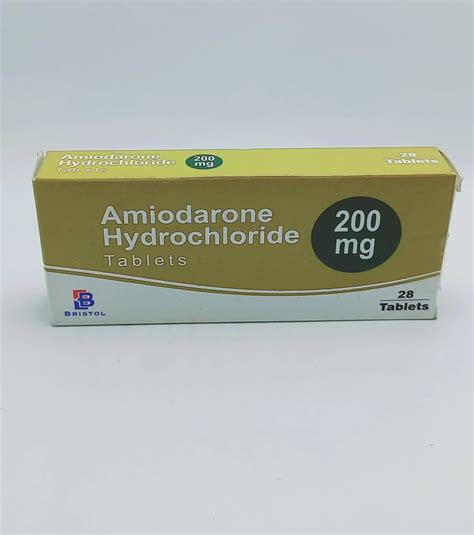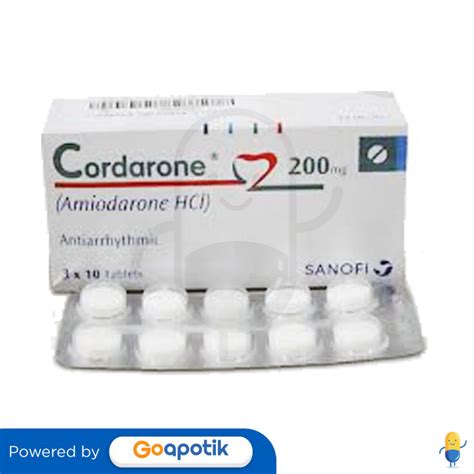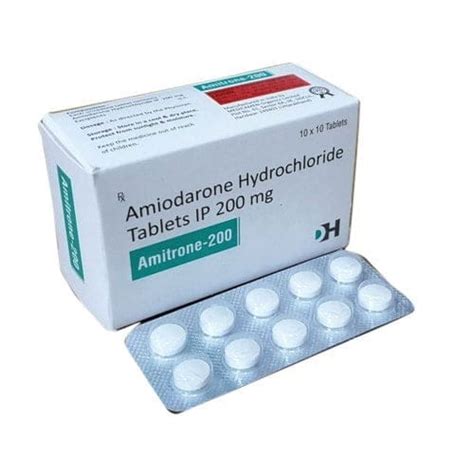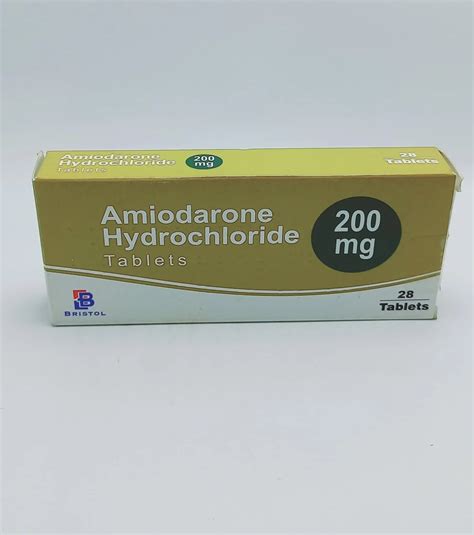Intro
Discover how Amiodarone 200mg works to treat irregular heartbeats, arrhythmias, and tachycardia, using anti-arrhythmic properties, ion channel blockade, and cardiac stabilization, providing effective cardiovascular care and rhythm management.
The importance of understanding how medications work cannot be overstated, especially when it comes to complex drugs like Amiodarone 200mg. Amiodarone is a powerful antiarrhythmic medication used to treat and prevent various types of irregular heartbeats. Its unique mechanism of action and wide range of effects make it a crucial drug in cardiology. However, its complexity also means that patients and healthcare providers need to be well-informed about its benefits and potential side effects. In this article, we will delve into the ways Amiodarone 200mg works, exploring its pharmacological properties, clinical applications, and patient considerations.
Amiodarone's multifaceted action is a key aspect of its therapeutic efficacy. It belongs to a class of medications known as antiarrhythmics, which are designed to restore a normal heart rhythm in patients with arrhythmias. The drug's ability to modulate various ion channels and receptors in the heart makes it highly effective against a range of arrhythmic conditions. From atrial fibrillation to ventricular tachycardia, Amiodarone 200mg has been shown to significantly reduce the recurrence of arrhythmic episodes, thereby improving patient outcomes and quality of life.
The pharmacokinetics of Amiodarone 200mg also play a critical role in its therapeutic profile. The drug has a long half-life, which allows for once-daily dosing and enhances patient compliance. Moreover, Amiodarone undergoes extensive hepatic metabolism, and its metabolites contribute to its antiarrhythmic effects. This complex pharmacokinetic profile necessitates careful monitoring and dose adjustment to minimize the risk of adverse effects. As we explore the ways Amiodarone 200mg works, it becomes clear that a deep understanding of its pharmacological and clinical properties is essential for maximizing its benefits while minimizing its risks.
Pharmacological Mechanisms of Amiodarone 200mg

Amiodarone 200mg works through several pharmacological mechanisms to exert its antiarrhythmic effects. These include blocking sodium, potassium, and calcium channels, as well as exhibiting beta-adrenergic blocking activity. By modulating these ion channels and receptors, Amiodarone can prolong the cardiac action potential and refractory period, reduce automaticity, and slow conduction velocity. This multifaceted approach allows the drug to effectively manage a wide range of arrhythmic conditions. The sodium channel blocking effect, for instance, is particularly useful in treating ventricular arrhythmias, while the beta-adrenergic blocking activity helps in reducing sympathetic tone and heart rate.
Clinical Applications of Amiodarone 200mg
The clinical applications of Amiodarone 200mg are diverse and reflect its broad spectrum of antiarrhythmic activity. It is commonly used to treat atrial fibrillation, atrial flutter, ventricular tachycardia, and ventricular fibrillation. In addition to its use in acute arrhythmia management, Amiodarone 200mg is also prescribed for long-term prevention of arrhythmic recurrences. Its effectiveness in maintaining sinus rhythm in patients with atrial fibrillation, for example, has been well-documented in clinical trials. Furthermore, Amiodarone's ability to reduce the risk of sudden cardiac death in high-risk patients underscores its importance in the management of life-threatening arrhythmias.Benefits and Risks of Amiodarone 200mg Therapy

While Amiodarone 200mg offers numerous benefits in the management of arrhythmias, its therapy is not without risks. Common side effects include gastrointestinal disturbances, fatigue, and thyroid dysfunction. More severe adverse effects, such as pulmonary fibrosis, hepatotoxicity, and cardiac conduction abnormalities, can also occur. The risk of these adverse effects necessitates careful patient selection, monitoring, and dose adjustment. Despite these risks, the benefits of Amiodarone 200mg therapy often outweigh the drawbacks, particularly in patients with life-threatening arrhythmias or those who have failed other treatments.
Patient Considerations and Monitoring
Patient considerations and monitoring are crucial components of Amiodarone 200mg therapy. Before initiating treatment, patients should undergo a thorough evaluation, including a baseline ECG, liver function tests, pulmonary function tests, and thyroid function tests. Regular monitoring during therapy is also essential to detect potential side effects early and adjust the treatment plan as needed. Patients on Amiodarone 200mg should be educated about the signs and symptoms of adverse effects and encouraged to report any changes in their condition promptly. Furthermore, the importance of adherence to the prescribed regimen and follow-up appointments cannot be overstated, as these factors significantly influence the success and safety of Amiodarone therapy.Practical Considerations for Healthcare Providers

For healthcare providers, several practical considerations are essential when prescribing and managing Amiodarone 200mg therapy. These include selecting the appropriate patient population, choosing the correct dose and formulation, and monitoring for efficacy and safety. Given the drug's complex pharmacokinetics and potential for drug interactions, careful consideration of concomitant medications is also necessary. Moreover, the role of patient education and counseling in promoting adherence and minimizing risks should not be underestimated. By addressing these practical aspects of Amiodarone 200mg therapy, healthcare providers can optimize patient outcomes and ensure the safe and effective use of this valuable medication.
Future Directions and Research
As our understanding of arrhythmia management continues to evolve, future directions and research in the field of Amiodarone 200mg therapy are likely to focus on optimizing treatment strategies, minimizing adverse effects, and exploring new indications. Emerging data on the genetic determinants of arrhythmia susceptibility and response to therapy may also lead to more personalized approaches to Amiodarone treatment. Furthermore, the development of new antiarrhythmic drugs and devices will continue to expand the therapeutic arsenal available to clinicians, potentially offering improved efficacy and safety profiles compared to existing treatments. As research advances, it is crucial for healthcare providers to stay abreast of the latest developments and incorporate evidence-based practices into their clinical decision-making.Clinical Evidence and Guidelines

The clinical evidence supporting the use of Amiodarone 200mg in arrhythmia management is extensive and has been summarized in various guidelines and consensus statements. These documents provide recommendations on patient selection, dosing, monitoring, and management of adverse effects, based on the best available evidence. By adhering to these guidelines, healthcare providers can ensure that their patients receive evidence-based care that is aligned with current standards of practice. The importance of staying updated with the latest clinical evidence and guidelines cannot be overstated, as this knowledge directly impacts patient outcomes and the quality of care delivered.
Conclusion and Final Thoughts
In conclusion, Amiodarone 200mg is a powerful and versatile antiarrhythmic medication that offers significant benefits in the management of various arrhythmic conditions. Its unique pharmacological mechanisms, clinical applications, and patient considerations make it a crucial drug in cardiology. As healthcare providers, it is essential to understand the ways Amiodarone 200mg works, including its benefits, risks, and practical considerations, to optimize patient outcomes and ensure the safe and effective use of this medication. By doing so, we can improve the lives of patients with arrhythmias and contribute to the advancement of cardiovascular care.What is Amiodarone 200mg used for?
+Amiodarone 200mg is used to treat and prevent various types of irregular heartbeats, including atrial fibrillation, atrial flutter, ventricular tachycardia, and ventricular fibrillation.
How does Amiodarone 200mg work?
+Amiodarone 200mg works by blocking sodium, potassium, and calcium channels, as well as exhibiting beta-adrenergic blocking activity, to prolong the cardiac action potential and refractory period, reduce automaticity, and slow conduction velocity.
What are the common side effects of Amiodarone 200mg?
+Common side effects of Amiodarone 200mg include gastrointestinal disturbances, fatigue, and thyroid dysfunction. More severe adverse effects, such as pulmonary fibrosis, hepatotoxicity, and cardiac conduction abnormalities, can also occur.
How should patients on Amiodarone 200mg be monitored?
+Patient monitoring during Amiodarone 200mg therapy should include regular ECGs, liver function tests, pulmonary function tests, and thyroid function tests to detect potential side effects early and adjust the treatment plan as needed.
What is the importance of patient education and counseling in Amiodarone 200mg therapy?
+Patient education and counseling are crucial in promoting adherence to the prescribed regimen, minimizing risks, and ensuring that patients understand the signs and symptoms of adverse effects and report any changes in their condition promptly.
We invite readers to share their thoughts and experiences with Amiodarone 200mg therapy, and to ask any questions they may have regarding its use and management. By engaging in this discussion, we can further our understanding of this important medication and work together to improve patient outcomes in the field of cardiology. Whether you are a healthcare provider seeking to optimize your treatment strategies or a patient looking to learn more about your medication, we encourage you to join the conversation and share your insights. Together, we can advance our knowledge and promote better care for individuals with arrhythmias.
